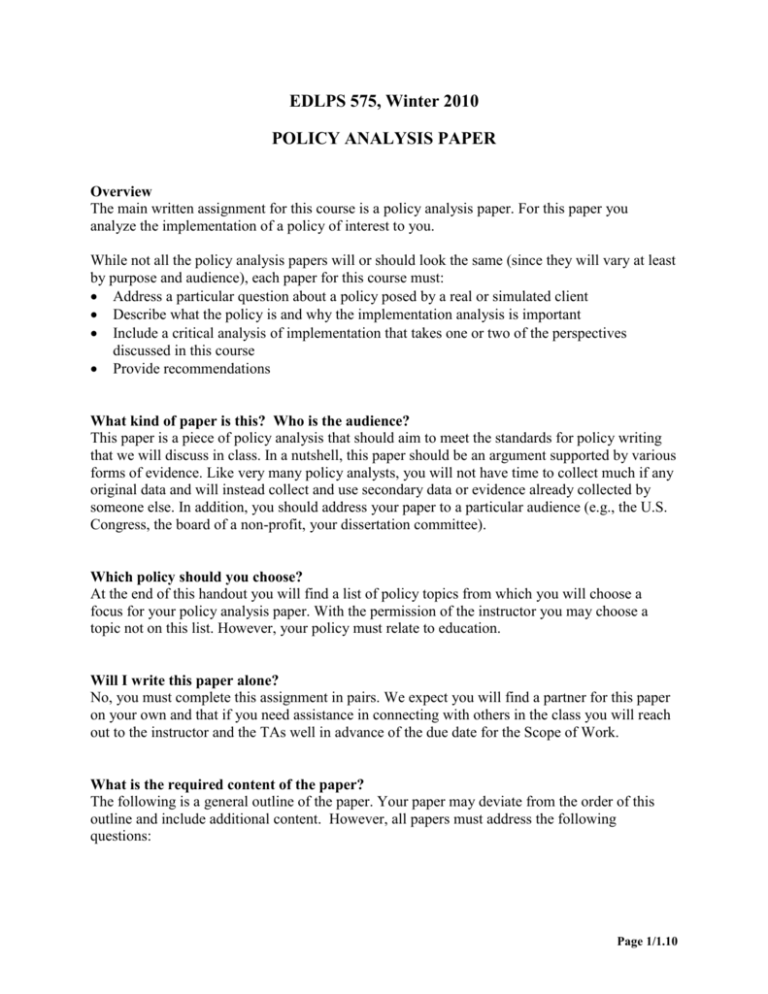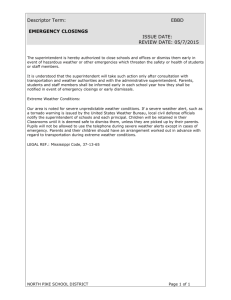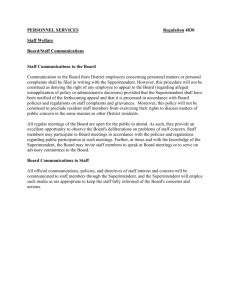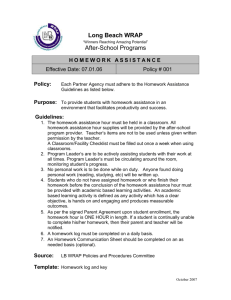SEMINAR PAPER - College of Education
advertisement

EDLPS 575, Winter 2010 POLICY ANALYSIS PAPER Overview The main written assignment for this course is a policy analysis paper. For this paper you analyze the implementation of a policy of interest to you. While not all the policy analysis papers will or should look the same (since they will vary at least by purpose and audience), each paper for this course must: Address a particular question about a policy posed by a real or simulated client Describe what the policy is and why the implementation analysis is important Include a critical analysis of implementation that takes one or two of the perspectives discussed in this course Provide recommendations What kind of paper is this? Who is the audience? This paper is a piece of policy analysis that should aim to meet the standards for policy writing that we will discuss in class. In a nutshell, this paper should be an argument supported by various forms of evidence. Like very many policy analysts, you will not have time to collect much if any original data and will instead collect and use secondary data or evidence already collected by someone else. In addition, you should address your paper to a particular audience (e.g., the U.S. Congress, the board of a non-profit, your dissertation committee). Which policy should you choose? At the end of this handout you will find a list of policy topics from which you will choose a focus for your policy analysis paper. With the permission of the instructor you may choose a topic not on this list. However, your policy must relate to education. Will I write this paper alone? No, you must complete this assignment in pairs. We expect you will find a partner for this paper on your own and that if you need assistance in connecting with others in the class you will reach out to the instructor and the TAs well in advance of the due date for the Scope of Work. What is the required content of the paper? The following is a general outline of the paper. Your paper may deviate from the order of this outline and include additional content. However, all papers must address the following questions: Page 1/1.10 Introduction What is your focal policy? What questions about the implementation of your focal policy will this paper address? What are the main points of your argument and what in sum will this paper recommend? Why should your audience be concerned/why is your audience concerned about your featured policy and questions? Roadmap: How is this paper organized? Implementation The focus of this main section of the paper will depend on the status of your policy’s implementation. IMPLEMENTATION UNDERWAY To what extent has the policy been realized in practice? Be specific about the quality of your evidence and its pros and cons. How do you explain implementation outcomes to date? Please choose no more than two explanations from the syllabus/course and use them to explain your implementation outcomes. Be sure to elaborate each explanation clearly and apply it to your case using appropriate course readings and evidence about your policy. IMPLEMENTATION NOT UNDERWAY To what extent is the policy likely to be realized in practice? Be specific about the quality of your available evidence and its pros and cons. On what do you base your assessment? Please choose no more than two explanations from the syllabus/course and use them to explain your predicted implementation outcomes. Be sure to define each dimension clearly and use evidence to explain how each helps predict how implementation may play out. Recommendations What’s next? Given your analysis, what if anything needs to be done? By whom? Why? When is the paper due and how is it graded? See the following chart for specific due dates. I will grade the final paper according to standards elaborated in the Grading Rubric distributed separately. The following table lists deadlines for this assignment. Page 2/1.10 ASSIGNMENT Scope of Work A 1-2 page, double-spaced paper (one per team) that addresses the following questions about your paper: Who are the members of your policy analysis team? On which policy will you focus? Why that policy—what’s important about it to warrant your policy analysis? What specific implementation questions will you address in your paper? Who is your audience/client? Why have you chosen that audience/client for this particular paper? What is your current sense of the kind of evidence that that audience/client might find particularly compelling? What is your rationale for focusing on those forms of evidence? What is your plan for accessing that evidence in time to write the paper? (Please provide a timeline of your activities to complete the paper.) OPTIONAL TA Review DUE DATE January 22 by 5pm DELIVERY February 26 by 5pm By e-mail to your assigned TA By e-mail to mihonig@ uw.edu Paper Draft Please submit a draft of your paper including an introduction and answers to the implementation questions posed above. You may also include recommendations if you wish but they are not required for this installment. March 4 by 5pm FINAL PAPER (One per team) March 14, 5pm E-mail to mihonig@ uw.edu By e-mail to mihonig@ uw.edu Page 3/1.10 Other information Use of course readings. You should draw heavily on readings from this course throughout your papers. Outside reading. To analyze your policy adequately, you must collect primary policy texts and other sources related to your policy. These sources may or may not include academic research articles. The relevance of the latter will depend in part on your audience and purposes in writing your analysis. But regardless of those dimensions of your paper you must draw on some evidence outside course readings to defend the claims in your analysis. Length. Your final paper should be no longer than 14 double-spaced pages (12-point font with 1inch margins) or 7 single-spaced pages. This page limit does not include the title page, bibliography, or brief appendices—should you choose to include those pages. The TAs and I will read papers (including drafts) up to that page limit. Papers significantly shorter than the page limit typically are not adequate. Clarity of writing. Sometimes students understand the material extremely well but produce papers that do not reflect that understanding due to unclear writing. Composing a paper that involves an argument backed by evidence poses challenges for most people. Accordingly, to help you with your writing, we have created an optional step in your drafting process that involves your submitting your draft to a TA for comments mainly on the clarity of your writing. We strongly encourage you to take advantage of that opportunity for feedback on your writing. If you are unable to meet the deadline for the optional TA review, we strongly recommend that you have someone else read your paper for writing clarity and that you scrub your paper carefully for spelling and grammatical errors. Typos and grammatical problems suggest to many readers that you have not done careful work. Citations/references. Please put all citations and references into APA style unless another style will be more appropriate than APA for your chosen audience. You may put your citations in endnotes or footnotes, depending on what format you think will be most appropriate to your audience. Page 4/1.10 TOPIC OPTIONS Note: Please choose one topic per paper-writing pair. The list below includes suggested topics and clients mainly related to public k-12 policies. Students interested in higher education and early childhood education as well as policies of private organizations will likely want to find a topic not on this list. The U.S. Department of Education’s Race to the Top Initiative According to the United States Department of Education (http://www.ed.gov/programs/racetothetop/index.html): “Through Race to the Top, we are asking States to advance reforms around four specific areas: Adopting standards and assessments that prepare students to succeed in college and the workplace and to compete in the global economy; Building data systems that measure student growth and success, and inform teachers and principals about how they can improve instruction; Recruiting, developing, rewarding, and retaining effective teachers and principals, especially where they are needed most; and Turning around our lowest-achieving schools. Awards in Race to the Top will go to States that are leading the way with ambitious yet achievable plans for implementing coherent, compelling, and comprehensive education reform. Race to the Top winners will help trail-blaze effective reforms and provide examples for States and local school districts throughout the country to follow as they too are hard at work on reforms that can transform our schools for decades to come.” As such, Race to the Top is an omnibus initiative involving various programs and funding streams. If you are interested in examining the implementation of Race to the Top, please choose a discrete policy within the initiative such as their grants related to school turnarounds. Possible Clients: The WA Office of the Superintendent of Public Instruction which is grappling with how to secure these funds even though Washington State falls short on various selection criteria including our laws that do not authorize charter schools. The United States Department of Education’s Office of Elementary and Secondary Education which is trying to anticipate challenges states, districts, and schools will face in implementation and design supports for implementation. Exit requirements for high school graduation in Washington State. In 2000, the Washington State Board of Education approved four high school graduation requirements to take effect with the class of 2008. One of the four requirements mandated that students meet state reading, writing and math standards and pass 10th grade assessments in each subject. In 2004, the state legislature codified the State Board’s requirements into state law (State's High School Assessment System outlined in the Revised Code of Washington [RCW] 28A.6555.061). Possible clients: Members of the State Legislature who are trying to understand why so many students recently failed the math portion of the WASL and how to ensure that the new math standards and assessments developed by the Office of the Superintendent of Public Instruction (OSPI) will produce better results. The National Conference of State Legislatures which is trying to help member states understand what happened in the State of Washington in order to avoid similar implementation failures in high school exit policies. Page 5/1.10 The OSPI which has launched new math standards and a High School Proficiency Exam to replace the WASL in the 2010-2011 school year and which wants to ensure that these efforts will substantially improve the chances for more students to meet high school exit requirements in math. Teacher Compensation Reform: ProComp in Denver Denver Public Schools’ (DPS) Professional Compensation System for Teachers (“ProComp”) arguably is among the most prominent examples of teacher compensation reform in public education today. ProComp aims to increase the recruitment and retention of high-quality teachers in Denver and improve student achievement by strengthening the relationship between teacher pay, productivity, and instructional practice. “ProComp” was developed collaboratively by DCPS and its teachers’ union and is funded by a special $25 million levy Denver’s voters approved in 2005. Possible Clients: DPS leaders who want to understand how ProComp is faring so far and how to improve the initiative. DPS leaders who want to use lessons learned from the implementation of previous teacher compensation reforms in other places to improve their initiative. Seattle Public Schools or another school district that may be considering adopting a ProComplike reform. School Contracting: LAUSD's Public School Choice Initiative Under the Public School Choice Initiative, Los Angeles Unified School District has begun soliciting bids from organizations to run dozens of its school campuses with a goal of turning 250 campuses over to such management in the next several years. This initiative, like a growing number of other “portfolio management” efforts across the country, rests on assumptions that if school districts turn over control of various school functions (if not whole schools) to non-profit and other organizations outside the school system, then schools will better serve students and all students distictwide will have access to several high-quality school options. “I believe there is an energy moving now among teachers, parents and administrators,” says LAUSD superintendent Ramon Cortines. “They don’t have to follow every policy, cross every ‘t’ or dot every ‘i.’ I am only interested in people coming forward with plans that raise the bar.” (LA Daily News, Oct 19, 2009). Possible Clients: A non-profit organization trying to decide whether or not to participate in this initiative. The LAUSD School Board or the Mayor of Los Angeles, trying to understand whether or not to continue support for this initiative. Another school system trying to decide whether or not to adopt portfolio management, based on the LAUSD experience to date. The U.S. Department of Education, interested in whether or not to launch a federal portfolio management initiative. Harlem Children’s Zone In New York City, Geoffrey Canada has been spearheading a major initiative to improve educational and other outcomes for youth in Harlem. Called the Harlem Children’s Zone, the initiative includes charter schools, an early childhood effort, and other programs designed to take a comprehensive approach to improving outcomes for youth. For example, rather than targeting just schools or health care or community development, the Harlem Children’s Zone focuses on improving the quality of services and supports for young people across sectors and doing so in a coordinated way focused on building community capacity for improvement. Possible Clients: Page 6/1.10 Private foundations in NYC who are wondering whether or not to continue their investment in the HCZ. Community organizers in Seattle who are lobbying the City Council to take a HCZ approach to improvement in the south end of Seattle. The U.S. Department of Education, trying to make recommendations to the President regarding his campaign pledge to create similar Children’s Zones in cities across the country. The Bill and Melinda Gates Foundation’s National High School Grants Program. In 2000 the Gates Foundation launched a major initiative to transform America’s high schools. Under the initiative, the Foundation made grants to intermediary organizations to start new high schools or redesign existing schools to better prepare low-income, African-American, and Hispanic/Latino youth for higher education and the workplace. Intermediary organizations worked with individual schools and/or central office staff to help them transform large comprehensive high schools into small schools or learning communities. After several years the Foundation terminated the initiative. Possible Clients: The Gates Foundation leadership who is trying to make sense of what happened with their investment in this initiative and whether or not they might revive it in the future. A school district that participated in the initiative [e.g., Oakland Unified School District, Chicago Public Schools] and wants to understand what happened during implementation, why, and implications for future school improvement efforts. A state educational agency (please select one) that is considering launching its own new small autonomous schools initiative and wants to draw on lessons learned from the Gates initiative. Schools Out Washington’s Improving Program Quality (IPQ) Project. Schools Out Washington (SOW) helps organizations across Washington state implement high-quality programs and opportunities for children during non-school hours. Through their IPQ Project, SOW provides free ongoing on-site training to licensed or certified child care and after-school programs to improve their quality. Such support includes increasing the information available to all after-school programs about best practices in after-school learning. Possible Clients: SOW which wants to know how implementation is going so far and how they might improve on their efforts in ways that are likely to improve program quality. A non-profit organization in another state that is considering how to implement an effort like SOW in their state. SOW which wants to understand why implementation of past after-school efforts such as 21st Century Learning Centers did not post significant gains in student achievement and how they might use those lessons to improve on their work. Teacher Professional Learning Communities in the Bellevue School District (BSD). The BSD currently mandates that schools create learning communities for its teachers as a main strategy for improving teacher practice and ultimately student learning. This mandate comes as part of the incoming superintendents new school improvement platform and after years of reform under former superintendent Mike Riley that by many accounts focused less on teaching than on creating a common mandated districtwide curriculum. Possible Clients: A consortium of principals in BSD who are trying to figure out how to implement professional learning communities well at their school. The superintendent in BSD who wants to know if the design of the PLC initiative is likely to yield results and what mid-course adjustments she might make. Page 7/1.10 A Washington Foundation, investigating whether or not the BSD effort is a good investment. Alliance for Community Teachers (ACT). Two years ago the UW Elementary Teacher Education program launched a new initiative (i.e., a policy) to place prospective teachers not only in schools but also in community-based youth organizations as part of their teacher preparation. Part of their theory of action posits that prospective teachers will learn more about children and their learning needs and opportunities if they engage with students not only in classrooms but in various settings that matter to their learning. Possible Clients: The UW Elementary Teacher Education Program which is trying to decide whether or not to continue the program. Faculty at a teacher education program at another university that plans to implement ACT and wants to anticipate implementation issues likely to help or hinder their progress. The Board of a local foundation that is trying to decide whether or not to make a significant investment in an endowment for ACT. Oakland Unified School District’s Results Based Budgeting. In 2004, as part of the “Expect Success” reforms, Oakland Unified School District (OUSD) instituted a school funding model called Results-based Budgeting (RBB). Formerly, schools received a budget from the central office that specified, with few degrees of freedom, how schools should spend their funds. Through RBB, schools now receive a lump sum of funding based on their total number of enrolled students and have significantly increased flexibility to decide how to spend these funds. RBB marks a radical departure from past budgeting systems in OUSD and many other districts in its focus on maximizing the amount of funding under school rather than central office discretion. Possible Clients: OUSD officials who want to understand how the policy is faring in order to better support school-level implementation. OUSD School Board, which recently re-gained control of the school system after being in state-receivership for fiscal mismanagement and which is trying to decide whether or not to continue or modify this policy. A district that is trying to decide whether or not to adopt a similar fiscal policy. A state or federal agency considering mandating a similar policy. Page 8/1.10











